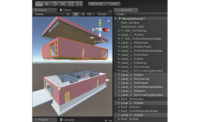Autodesk announced on Nov. 20 that it has signed a definitive agreement to acquire the seven-year-old construction technology startup PlanGrid for $875 million “net of cash,” meaning that is what PlanGrid and its investors will net after deducting PlanGrid’s available cash balance from the gross acquisition value.
In a call with ENR on Nov. 21, Autodesk vice president Jim Lynch, who serves as general manager of the software vendor’s construction business unit, and Tracy Young, PlanGrid’s co-founder and CEO, explained the drivers behind the acquisition and their goals for the technology development going forward.
 |
| Left to right, Autodesk vice president Jim Lynch, who is general manager of the software vendor’s construction business unit, Tracy Young, PlanGrid co-founder and CEO, and Andrew Anagnost, Autodesk CEO. PHOTO CREDIT: PlanGrid |
Lynch says Autodesk’s strategic purpose is to strengthen the connection between the construction activity on the jobsite, and its Revit design tools and BIM 360 construction management platform. The jobsite is exactly where PlanGrid was created to land and where it has excelled in establishing itself. According to Autodesk’s announcement, PlanGrid has been used on more than a million projects and has 120,000 paid users.
“A year and a half ago, when Andrew [Anagnost] became our CEO, he made it very clear that our focus would be on construction and that this is a transformational opportunity for the company,” Lynch said, “and as we looked at our portfolio and strategy for ways to accelerate that strategy, we realized the importance of getting a bigger presence out in the field and on the jobsite.”
Lynch says his team had been watching PlanGrid closely for some time and admires “the incredible momentum that they have,” and the way Tracy Young can “go on a jobsite, demonstrate PlanGrid, take a sale by credit card and have it being used an hour later” to synchronize plans and documents with construction in the field. “And we thought to take BIM 360 from design and preconstruction to design execution, it made all the sense in the world.”
Lynch says Autodesk proposed the acquisition “about two months ago.” The deal is “subject to customary closing conditions,” but is expected to close by the end of January.
When asked to comment on the price and its relationship to PlanGrid revenue, Young declined to reveal PlanGrid’s current revenue, although in a briefing about the acquisition, Autodesk stated that it expects PlanGrid to contribute about $100 million in ARR (annual reoccurring revenue) in fiscal year 2020 “and be slightly dilutive to profitability and cash flow.” Young did say, however, “There was no bidding war. When you think about the companies that could have bought us, the ones that were big enough, this is the one that makes sense; Autodesk and PlanGrid.”
Both Lynch and Young said, “The price was fair,” although Young noted in an aside that, “companies are bought, and not sold,” and added, “between their offer and the obvious energy of our technology, is really why we made the decision.”
Next steps:
Getting these two [BIM360 and PlanGrid] talking together is going to be job one, because we think this is so compelling,” says Lynch. “We need to synch sheets and plans between BIM360 or from PlanGrid so it doesn’t matter whether it’s coming from BIM360 or from PlanGrid,” he said, adding, “I don’t think it’s going to take rocket science. I think we are go to get there pretty quickly … but I don’t want to predict how long until we start having our planning meetings.”
Lynch says Young will now run PlanGrid from within Autodesk, and Young says her goal for it remains the same as it was when she gathered together some talented people with varied skills to co-found the company in late 2011. Her mission was to develop software for the newly released iPad and mobile platforms to solve document coordination problems she was having as a construction engineer trying to work with a blueprint- and paper-based workflow.
“Our vision was always to become the construction record-set for all the jobsites in the world,” Young says. “We have been working for the last 7 years [and] that has always been our vision, but as Jim and I were talking, we realized we could achieve and realize our vision much faster if we worked together. The future of construction is connecting the field to the office. With the direct connection with BIM 360 and being part of Autodesk, now we can just do so much more for the industry than was possible.”
“I am a builder by trade and we built the tool we wanted to use in the field,” Young adds. “Now we are over 400 people strong, and it’s still all about building—but instead of concrete and wood and glass and rebar, the medium is building with people, code, communications architecture, processes, products, software and a lot of customer interactions.”
Young says PlanGrid’s users have reacted very positively. “There are a lot of customers that use both of our products that have been wanting this to happen,” she says. “They have been living the disconnect between design and construction. Our customers understand that this completely changes the construction technology landscape. We’ve only scratched the surface of what we can do: Digitalizing of their workflow is only the start, its what we invent going forward from this that’s going to be really exciting.”
“We have been telling our customers we are serious about construction,” Lynch adds. “This really demonstrates that. All I would say is get ready for next year. It’s going to be a big year for Autodesk and construction. Our customers are going to benefit hugely from this.”




Post a comment to this article
Report Abusive Comment